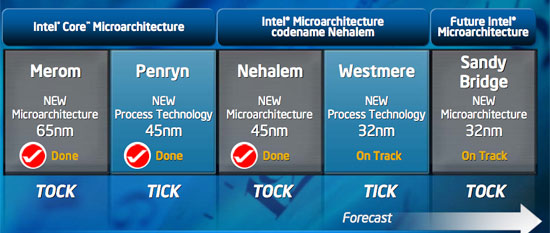Intel's 32nm Update: The Follow-on to Core i7 and More
by Anand Lal Shimpi on February 11, 2009 12:00 AM EST- Posted in
- CPUs
Tick-Tock: U R Doin it Right
Let’s check the stats; Conroe in July 2006, Penryn in October 2007, Nehalem in November 2008. That’s a tock, tick, and another tock, each about a year apart. Note that the cadence does appear to be slipping a bit, but we’ll see exactly when in 2009 we get Westmere before making any accusations.

The next tick is, as I just mentioned, Westmere. It’s a 32nm shrink of Nehalem, much like Penryn was a 45nm shrink of Conroe/Merom. And it’s due out in the fourth quarter of this year.
Yesterday, Intel demonstrated working versions of its 32nm processors in both desktops and notebooks. The notebook aspect of the demonstration is very important, which I’ll get to later. Both mobile and desktop versions of Westmere will be shipping from Intel in Q4.
Getting Complicated with Code Names
Nehalem is the overall name for Intel’s 45nm desktop/mobile/server product family. At the high end we have Bloomfield, which is the quad-core, eight-thread, Core i7 processor we all long for. That’s the only Nehalem derivative that’s launched thus far.
| Segment | Manufacturing Process | Socket | Processor | Cores | Threads | Release Date |
| High End Desktop | 45nm | LGA-1366 | Bloomfield | 4 | 8 | Q4 2008 |
| Mainstream Desktop | 45nm | LGA-1156 | Lynnfield | 4 | 8 | 2H 2009 |
| Mobile | 45nm | mPGA-989 | Clarksfield | 4 | 8 | 2H 2009 |
| 4S Server | 45nm | LGA-1567 | Nehalem-EX | 8 | 16 | 2H 2009 |
| 2S Server | 45nm | LGA-1366 | Nehalem-EP | 4 | 8 | 1H 2009 |
| 1S Server | 45nm | LGA-1156 | Lynnfield | 4 | 8 | 2H 2009 |
By the end of this year we’ll see Lynnfield and Clarksfield. These are both quad-core, eight-thread Nehalem processors but at lower TDPs and price points. They will fit into Intel’s unannounced LGA-1156 socket and only support two channels of DDR3 memory (compared to LGA-1366 and 3-channels with Core i7).
On the server side we’ll have Nehalem-EX, an 8-core, 16-thread version. Nehalem EP a 4-core, 8-thread version. And Lynnfield again for the entry level servers.
These are all 45nm parts and all due out by the end of this year.
Note that there’s one name missing: Havendale. Havendale was supposed to be a 2-core Lynnfield + on-chip graphics, perfect for notebooks and low end desktops where quad-core isn’t necessary. Unfortunately, Havendale got delayed until Q4 2009 with systems shipping in Q1 2010. That just happened to coincide with Intel’s 32nm ramp so a very significant decision was made: Havendale got scrapped.










64 Comments
View All Comments
Jovec - Wednesday, February 11, 2009 - link
Take a look at your Program Menu and tell me what apps today that are not multithreaded would receive serious benefit from being multithreaded? Besides gaming? Single-thread apps do receive benefits from multiple cores in typical usage scenarios because they can be run on a (semi) dedicated core and not interfere with other apps.philosofool - Wednesday, February 11, 2009 - link
Interesting thought. I'm hoping that with the mainstreaming of the dual core, multi-threaded apps become more common and that the single to dual jump turns out to be the biggest leap. But it's really just a hope on my part, don't know if it will happen.Isn't there a multitasking advantage with 4 core machines? Also, once we start ripping 720 and 1080p files, 6 cores is gonna be hot.
7Enigma - Thursday, February 12, 2009 - link
There are definite multitasking advantages with quadcore if you are heavily multitasking (i'd argue tri-core is probably used more effectively currently than that final 4th core). Single to dual, however, was a much greater difference for multitasking on the whole.I just don't see the quad-hex jump being more beneficial than quad-juicedquad in this case.
strikeback03 - Wednesday, February 11, 2009 - link
Yeah, can't say I'm real happy about the lack of a 32nm quad-core for 1366. If my motherboard supported Penryn I'd probably just buy one of those cheap, getting an SSD, and waiting for Sandy Bridge. Since it doesn't, the decision is more difficult. Probably depends how much business I get this year.Pakman333 - Wednesday, February 11, 2009 - link
DailyTech says Lynnfield will come in Q3? Hopefully it will have ECC support.iwodo - Wednesday, February 11, 2009 - link
SSE 4.2 doesn't bring much useful performance to consumers.There is no Dual Core Westmere or Nehalem. Not without Intel Sh*test Graphics On Earth.
No wonder why Unreal Dev and Valve are complaining that Intel GFX is basically Toxic....
And i cant understand why Anand is excited, Macbook with Intel Graphics all over again?
And Just before anyone who say Intel Gfx will improve. Please refer to history, from G965 to their X series are so full of Marketing BS.... And never did they delivery what they promised.
ssj4Gogeta - Wednesday, February 11, 2009 - link
noone's forcing you to use G45. you can still use discrete gfx cards.Daemyion - Wednesday, February 11, 2009 - link
Actually, they fully delivered on the marketing. It's just that when Nvidia/ATI delivered products in the same space Intels product looked rubbish. There is nothing wrong with the G45 other than it not being an 9400 or a 790GX.Spoelie - Wednesday, February 11, 2009 - link
wasn't yonah the first processor out at the 65nm node? if so intel did perform the same stunt earlier, only at 45nm did they not release a laptop version first.IntelUser2000 - Wednesday, February 11, 2009 - link
No, the Pentium 955XE based on Pentium D was.